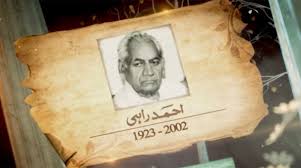علم صوتیات کی روشنی میں ، احمد راہی کی "رگِ جاں" کا تجزیاتی مطالعہ
An analytical study of Ahmad Rahi's "Rag-e-Jan" in the light of phonetics
##semicolon##
Ahmad Rahi##common.commaListSeparator## Rag-e-Jan##common.commaListSeparator## phonetic analysis##common.commaListSeparator## euphony##common.commaListSeparator## stylistics##common.commaListSeparator## Urdu poetry##common.commaListSeparator## sound symbolism##article.abstract##
The present research, “An Analytical Study of Ahmad Rahi’s Rag-e-Jan in the Light of Phonetics,” explores the intricate relationship between sound and meaning in the poetic expression of Ahmad Rahi. As one of the most influential voices in modern Urdu and Punjabi poetry, Rahi’s Rag-e-Jan exhibits a unique harmony of emotional resonance and phonetic artistry. This study examines how phonetic features such as euphony, consonance, assonance, rhythm, and intonation contribute to the lyrical texture and emotional depth of his verse. Through a detailed phonetic analysis, the research seeks to uncover how Rahi’s sound patterns enrich the semantic layers of his poetry and reflect the cultural, emotional, and linguistic sensibilities of his era.Drawing upon the theoretical frameworks of phonological stylistics and modern sound symbolism, the study investigates the interplay between phonetic structure and poetic meaning. Special attention is given to the ways in which Rahi employs auditory elements to express themes of love, nostalgia, pain, and existential reflection. His deliberate use of sound not only enhances musicality but also serves as a vehicle for emotional communication and aesthetic coherence.Ultimately, this research contributes to Urdu literary criticism by integrating linguistic and phonetic perspectives into the study of poetic form and function. It broadens the understanding of Ahmad Rahi’s poetic art as a symphony of sound and sentiment, where phonetic beauty becomes an essential element of his creative expression.
##plugins.themes.default.displayStats.downloads##
##submission.citations##
1۔ احمد راہی، رگِ جان،لاہور:الحمد پبلشرز ،2005ء، ص 84
2۔ گیان چند جین، پروفیسر، عام لسانیات، نئی دہلی: انجمن ترقی اردو ، 1985ء، ص17
3۔ ڈیوڈ کرسٹل، لسانیات کیا ہے؟، مترجم: نصیر احمد خان، لاہور: نگارشات، 1992ء، ص44
4۔ خلیل صدیقی، آواز شناسی، ملتان: بیکن بکس، طبع اول، 1993ء، ص 14
5۔ علی رفاد فتیحی، اردو لسانیات، نئی دہلی: قومی کونسل برائے فروغ اردو زبان، 2013ء، ص5
6۔ فہمیدہ بیگم، شعور زبان، دہلی: موتی باغ، 1990ء، ص117
7۔ عبدالقادر سروری، پروفیسر، زبان اور علم زبان، حیدر آباد دکن: انجمن ترقی اردو، 1956ء، ص56
8۔ احمد دہلوی، سید، علم اللسان، فرہنگ آصفیہ، لاہور: سنگِ میل پبلی کیشنز، 1901ء، ص 11
9۔ محمد ظہیرالدین، اردو میں صوتیاتی اور فونیمیاتی تحقیقات، 2018ء، ص 13
10۔ مفتی تبسم، پروفیسر، آواز اور آدمی، حیدرآباد: نیشنل فائن پرنٹنگ پریس، 1983ء، ص 12
11۔ سہیل بخاری، ڈاکٹر، تشریحی لسانیات، لاہور: فضلی سنز، 1997ء، ص 21
12۔ شوکت سبزواری، ڈاکٹر، اردو لسانیات، علی گڑھ: ایجوکیشنل بک ہاؤس، 1990ء، ص 177
13۔ گوپی چند نارنگ، اردو کی تعلیم کے لسانی پہلو، دہلی:اردو اکیڈمی، ص43
14۔ خلیل بیگ، مرزا، اردو لسانیات، حیدرآباد:1998ء، ص 26
15۔ اقتدار حسین، لسانیات کے بنیادی اصول، علی گڑھ: ایجوکیشنل بک ہاؤس، 1985ء، ص 1
16۔ محمد حسین، ڈاکٹر، اردو لسانیات: ایک تعارف، مشمولہ: اردو ریسرچ جنرل، دہلی: جولائی ستمبر 2017ء، ص 87
17۔ شوکت سبزواری، ڈاکٹر، اردو لسانیات، ص 44

##submission.downloads##
##submissions.published##
##issue.issue##
##section.section##
##submission.license##
##submission.copyrightStatement##
##submission.license.cc.by4.footer##Authors retain the copyright of their work. All articles in Scholar Insight Journal are published under the terms of the Creative Commons Attribution 4.0 International License (CC BY 4.0).
This license permits anyone to read, download, copy, distribute, print, search, or link to the full texts of the articles, and to use them for any other lawful purpose, without asking prior permission from the author(s) or the publisher, provided proper attribution is given to the original work.




